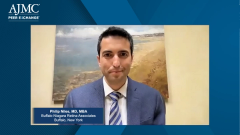
Management of Anti-VEGF Agents in Wet AMD and DME
Philip Niles, MD, MBA; Kevin U. Stephens, Sr., JD, MD; Nicholas G. Anderson, MD; and Jim Kenney, RPh, MBA, comment on managing the utilization of anti-VEGF agents for wet AMD and DME, including the impact of step edits on care.
Episodes in this series

Jim Kenney, RPh, MBA: Do you have any experience with step edits or restrictions on product preferencing that require you to sort of step through an agent that perhaps you’re not necessarily in favor of as a first-line treatment?
Philip Niles, MD, MBA: I would say step edits have become pretty widespread right now. There are a lot of Avastin [bevacizumab]-first policies because of its cost and because for some patients, it happens to work very well. There are a lot of different elements that as a clinic we see. Whatever you’d like to call them, whether it’s step edits, prior authorization, delayed payments, there are a lot of different levels of complexity, as there should be. It’s a pretty expensive medicine that we’re using. When I was looking at anti-VEGF agent costs to Medicare Part B, it was $4.2 billion last year, but in managing those costs there are a lot of costs of the system that go along with that. We actually have a couple of full-time equivalent employees who are dedicated to interfacing with insurance companies. Different levels of restrictions have definitely impacted how we practice and the drugs that we can choose sometimes.
Kevin U. Stephens, Sr., JD, MD: I can chime in also. With this, I want to highlight the process a little so that everyone can be clear. When you put in the request for prior authorization, usually the most common reason for a denial is lack of sufficient clinical information. So the more information you put in place in your prior authorization request, that helps the reviewing physician look at the criteria. Many times the first reviewer may not be a retina specialist, I would say it’s probably not a retina specialist. So you have to make where they can look at the criteria and look at the clinical picture, and then they can match it and improve it. The second thing is, if it is denied for whatever reason it may be, then you can also have a peer-to-peer review, where you can get the medical director who reviewed it on the phone and say, “Look I think this is a difficult case, and this patient should have this therapy because A, B, and C.” Thirdly, if that didn’t get you the outcome that you wanted, then you also have the right to appeal. I want to highlight that that’s a very important right because in the appeal, the reviewing physician has to be in a similar or like specialty so that you can have someone who can really look at the facts of the details to make sure that if it’s denied, that it’s valid and it’s the standard of care, so to speak. I think that understanding the process is important because many times you do get denials, and many times it’s for various reasons, but the most important reason as I mentioned earlier is the lack of sufficient clinical information. I think this can help us to work better together.
Philip Niles, MD, MBA: I agree. I actually give our payer colleagues a lot of credit on this. We almost never get a prior authorization denied for anti-VEGF use. I give them a lot of credit for that, because on our end, we recognize how important it’s to provide health care in a sustainable fashion, especially when the medicines cost as much as they do. Typically we’re able to use the medicine that we want to use for patients.
Nicholas G. Anderson, MD: We have step edits in Tennessee, and I certainly understand the rationale behind step edits. I tend to think they’re perhaps a blunt instrument for such a specific problem. When they look at the data across the country, if you look at regions, states, or even individual practices that are subject to step edits and compare those to practices or regions that aren’t subjected to step edits, the utilization allocations really aren’t that different. Most of us as practicing physicians are typically using the treatment protocols that the payers are trying to enforce with step edits anyway. I tend to think they’re maybe a blunt instrument that’s not as effective as it could be. It ends up sometimes just becoming a barrier to care.
I know Dr. Stephens has referenced the peer-to-peer reviews, but many of our practices, mine is certainly one of the largest in the country, and we’re literally performing tens of thousands of these injections every year. I personally care for several thousand patients. Most of us, frankly, don’t have the time to get on the phone. It can often take 20 minutes to do a peer-to-peer. So it’s taking time away from my limited ability to provide care to patients. That 20 minutes that I’m spending on a peer-to-peer is time I perhaps could have better spent taking care of a patient.
In the end, after a peer-to-peer, I almost never find that the payer denies the payment. If we’re simply requesting a physician spend lots and lots of time on peer-to-peer reviews and then approving the treatment the physician requests, is it really effective? So again, if you look across the country, there’s not a huge difference in utilization between regions that do have step edits and those that don’t have step edits. Physicians are already putting protocols in place to practice the way that the step edits are intended to enforce. When we do try to make a progression to a different medication, perhaps a branded medication, and we get an initial denial, and then we do a peer-to-peer, and the authorization rate after a peer-to-peer, I would wager as probably greater than 95%. Is that peer-to-peer really necessary, or is it just a barrier?
Philip Niles, MD, MBA: I agree with everything Dr. Anderson just said, and I do give our payer community, a lot of credit because while we really believe that every patient should get the care and the medicine that’s best for that person, it’s easy to believe that while UnitedHealthcare is paying for it, or while our payers are paying for it. And it’s an enormous bill. I think we all recognize the benefits of the vision, and we just hope to be good partners. I think any retina doctor in any community is looking to be a good partner in providing care for these patients who really need it, and to partnering with our payers and working together to collaborate and provide great policies. I don’t think we’ve done a great job of that as a retina field—working hand in hand with payers to design a good way forward. But I think that’s something that we’re going to improve on in the next couple years given the increasing cost of the medications.
Jim Kenney, RPh, MBA: Well there are certainly a lot of data available, there is a lot of claims activity and claims history at all the plans that could be mined and shared. If you look at the approvals and denials of requests, we did that at my former plan routinely, and would make adjustments year over year. If we found that we were approving 95% of the requests, then we took the prior authorization away because it wasn’t really serving any purpose. You certainly make a good point, Dr. Anderson, in terms of that maybe being a barrier in some instances. But in other cases, it can be employed very favorably because it encourages providers to perhaps use a different therapy, but it sounds like there’s less of a need for that in this particular field. I think that type of utilization, if you could share that with the plans, from whatever sources you are using, whether it’s coming from manufacturers, whether it’s coming from your associations, could be very helpful. Say, “Look in this case there’s no difference.” I’ve had manufacturers tell me that, one plan down the street that has a closed formulary has the exact same utilization as the plan in the other direction that has an open formulary. And so the formulary structure doesn’t make a difference because the patient need and the physician needs are the same. I think if we could share that information somehow we could streamline the process in select therapeutic areas like DME [diabetic macular edema] or AMD [age-related macular degeneration]. So I think some good feedback, good conversation.
Nicholas G. Anderson, MD: We have a very tight relationship with our payers, and we do share those data and that information, and we have been able to implement changes. Going back to the collaboration point, there are a lot of policies put in place in almost any industry, in almost any specialty. We certainly understand the impetus for those protocols to be enforced. But I think it’s important to see those policies put in place, then take some time to evaluate them, see if they’re effective. And then have the practice go back and directly work with the payer to see, “Hey, this is working great. We need to keep doing this, this has been great for our patients, it’s been very cost effective. Let’s keep doing this protocol.” On the other hand, “Let’s take a look at this protocol. This really isn’t serving the patients as well as we think it should. Maybe we should revisit whether it’s appropriate to keep this policy in place.” And to their credit, most of the payers have worked with us very carefully on some of these protocols. We keep some, we reverse others, and we try to keep moving forward to do what’s best for our patients.
Transcript Edited for Clarity
Newsletter
Stay ahead of policy, cost, and value—subscribe to AJMC for expert insights at the intersection of clinical care and health economics.




























































